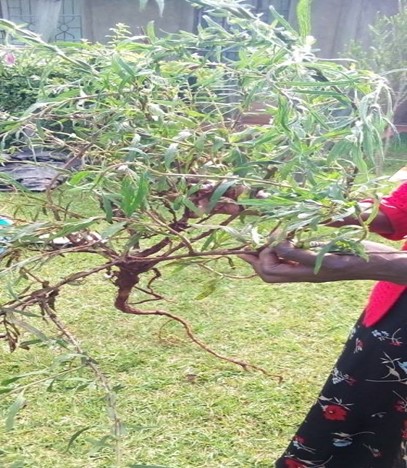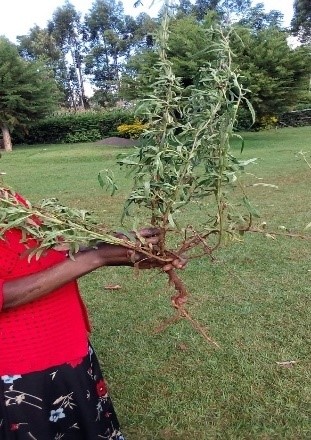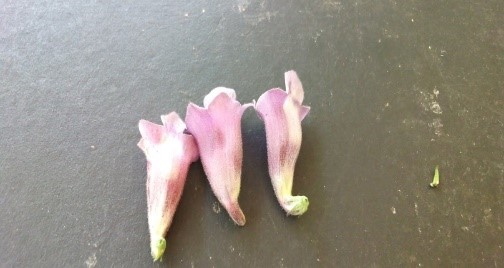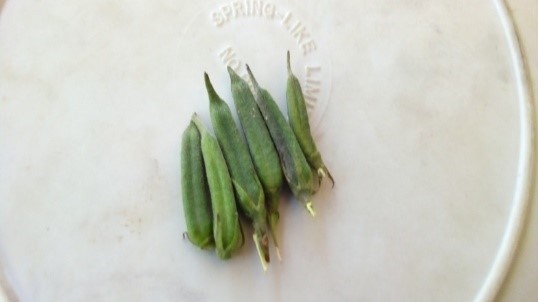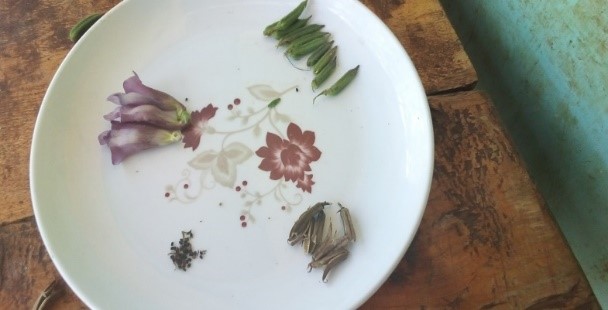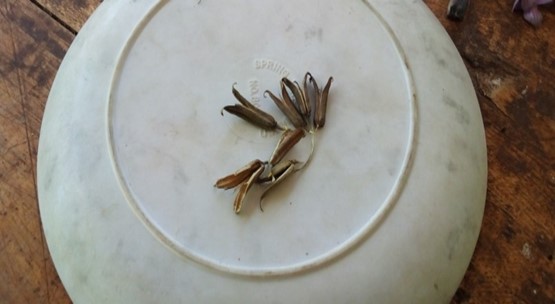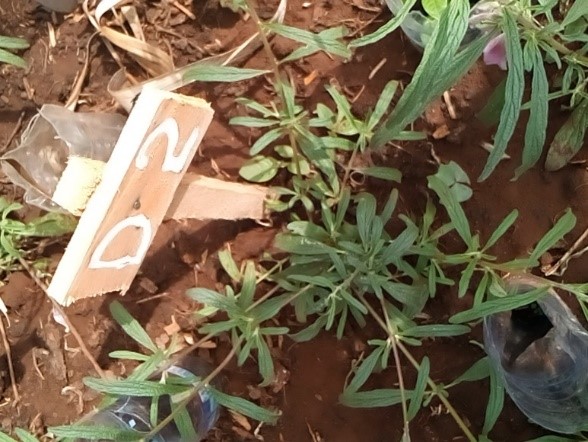Identification of Morphotypes in Wild Simsim (Sesamum Calycinum) from Khwisero, Kakamega using Morphological Techniques
- Bunde M.A
- Omami E.N
- Opile W.R
- Were G.
- 402-409
- Jun 5, 2024
- Agriculture
Identification of Morphotypes in Wild Simsim (Sesamum Calycinum) from Khwisero, Kakamega using Morphological Techniques
Bunde M.A*1., Omami E.N1., Opile W.R1., Were G.2.
1Department of Seed, Crop and Horticultural Sciences, School of Agriculture and Biotechnology, University of Eldoret. P.O Box 1125-30100 Eldoret, Kenya.
2Department of Family and Consumer Sciences, University of Eldoret
*Corresponding Author
DOI: https://doi.org/10.51244/IJRSI.2024.1105026
Received: 04 April 2024; Revised: 29 April 2024; Accepted: 04 May 2024; Published: 05 June 2024
ABSTRACT
Wild simsim (Sesamum calycinum) is among the wild and weedy edible leaf relatives of the sesame, Ceratotheca and Sesamumgenus found in Africa. The vegetable is still gathered from the wild especially during the dry periods Despite the economic and social importance of the vegetable, it has never been domesticated and is in danger of extinction due to the introduction of exotic vegetables and cash crops in its natural habitat. Crop improvement programmes focus mainly on the different traits inplants that can be used for breeding purposes. The field experiment was conducted in Lugari sub–county, Kakamega County aimed at identifying the different morphotypes in wild simsim from Khwisero, sub-county, Kakamega County using qualitative and quantitative descriptors outlined by International Plant Genetic Resource Institute. The seeds were planted in an experimental plot and the plants were observed for different morphological traits at maximum vegetative phase. The results revealed the existence of two morphotypes based on growth type the “indeterminate” and the “determinate” type having the erect and prostrate growth respectively. The morphotypes did not differ in the qualitative traits in stem, leaves, inflorescence, capsule and seed. However, a difference was recorded in plant height, the number of branches, size of leaves, capsule size and the number of seeds per capsule. The indeterminate type recorded a mean height of 56.4cm with fewer branches (17) while the determinate height stood at 42.5cm having more branches (24). The determinate type recorded a leaf area of 53 cm2 while the indeterminate was 36.1 cm2. In conclusion, two morphotypes were identified the” indeterminate” and ‘determinate” types. The determinate type is recommended due to the prediction of high leaf yield observed in more branches and a higher leaf area.. This information can be used as a base for breeders and domestication of wild simsim.
INTRODUCTION
Wild simsim belongs to the Pedaliaceae family whose leaves are important for health and nutrition in many African communities (Bedigan, 2018). Botanical studies indicate many Pedaliaceae species with wide diversity in morphological traits and chemical composition (Bedigan, 2018). Wild simsim is among the undomesticated and uncultivated indigenous ALVs, andas a major step towards domestication of the vegetable, the different morphotypes growing wildly need to be identified and described. The genus Sesamum consists of several wild species distributed with only one cultivated species Sesamum indicum with diverse genetic polymorphism (Patil et al., 2016). According to International Union for Protection of New Plant Variety (UPOV), new characters used in varietal characterization should be clearly defined and accepted and should have a standard method of observation (Vanishree et al., 2022).Studies indicate a wide diversity in plant growth habits, plant height, leaf, flora and pod characteristics (IPGRI and NBPGR, 2004). The diversity in trichrome types in Solanum species gave a base for a study on breeding for pest resistance (Watts and Kariyat, 2021). While identifying varieties through morphological characters, plant and seed characters need to be studied and documented thoroughly (Bhootet al., 2019).While using morphological techniques, characterization descriptors and evaluation descriptors are used. Characterization descriptors allow a quick identification between phenotypes and are highly heritable and seen by naked eyes while evaluation descriptors depend on environmental conditions and include yields (IPGRI and NBPGR, 2004).
Morphological features of genotypes have been a major component of varietal identification (Salaet al., 2023). Rinchen et al., (2017) observed variations in morphological traits in plant, leaf color and leaf margin in Triplex hortensis vegetables. Black nightshade genotypes showed a diversity in plant height, internode length and leaf yield (Wesonga et al., 2016). Mavi et al, (2021)reported a variation in the number of seeds per capsule in a sponge gourd. Nguyen (2016) observed differences in cotyledon size, fruit weight and fruit length in indigenous and non-indigenous cucurbits. Sesamum varieties assessed for 13 morphological traits recorded variations in qualitative traits of petal colors and petal hairiness and branching type (Sala et al., 2023). Morphological diversity was observed among the different accessions of Clotalariabrevidens and Clotalariaochraleuca in both quantitative and qualitative traits (Mwakhaet al., 2020). Dua to the scanty informationon thedifferent morphotypes in wild simsim, the experiment aimed at identifying the morphotypes in wild simsim from croplands in Khwisero.
MATERIALS AND METHODS
Wild simsim capsules were harvested in crop fields in Khwisero, Kakamega County at the yellow capsule stage and dried under shade. Khwisero lies in the Lower Midland zone (LM1) with sandy clay soils (Jaezoldet al., 2010.The seeds were gently removed from the capsules and stored in brown bags for 35 days at room temperature (190 – 210C) in a cool dry environment (Jyotiet al., 2021). A sample of wild simsim plant was taken to the botany laboratory for genus and species confirmation with the assistance of a taxonomist from the Department of Botany at the University of Eldoret. Matching the botanical description with the sample, the plant was confirmed to be Sesamum calycinum
Experimental site.
The field study was conducted in Lugari.Kakamega County, Lugari Sub-county which is located at latitude (0.25038’59.99”N) and longitude (34.39050’59.99’’E). Altitude ranges from 1300 – 1800 m above sea level with an association of well-drained, moderately deep to deep friable clay, ferrasols, greysols and sandy soils. The area lies in Upper Midland 3 and 4 (UM-UM4) agro- ecological zones suitable for dairy, maize, sunflower, grain amaranth and horticultural production. Normally, the area experiences long rains from the end of March with a long cropping season while the short rains come in September. The average rainfall is about1600 mm with temperatures 230 C- 250 C (Jaezoldet al., 2010).
The limitation of the study
The wildsimsim seeds were got from one area and we cannot conclude that these are the only morphotypes in wild simsim. This was basic research on an undomesticated vegetable, and there was very information on production and literature review.
Planting and Management
The experimental plot measuring 10 × 10 m was prepared to a fine tilth and compost manure was applied at a rate of 30 tons/ ha. The seeds were shallowly drilled in farrows 30 cm apart and covered lightly with soil. Thinning was done when the seedling had attained a height of about 5 cm whereby the weak and extra seedlings were removed to achieve the recommended spacing of 15 cm between the plants (Ashri, 2007). Weeding and other agronomic practices were done accordingly. The plants were observed for morphological traits at maximum vegetative state (50% flowering) according to sesame descriptors (IPGRI and NBPGR, 2004).To assess the quantitative descriptors, the mean of at least five measurements per individual morphotype was recorded while for the qualitative traits physical observation wasmade according to the guidelines provided.
RESULTS
A close observation of the plants in the plot at the vegetative stage revealed the presence of two distinctive morphotypes based on plant growth type i.e. the indeterminate and the determinate types. To enable a thoroughobservation of the other characters, the indeterminate types were temporally referred to as Morphotype 1 (MI) while the determinate types were referred to as Morphotype 2 (M 2). The plants were then tagged accordingly to facilitate the activity The morphotypes were then observed for both qualitative and quantitative plant, stem, leaf, inflorescence, capsule and seed characteristics.
Plant Characters
Morphotype 1 (M 1) was the indeterminate growth type having the erect growth habit, while morphotype 2 (M 2) was the determinate type and prostrate in growth habit. They all hada deep thin tap root system (table1).
| Plant characters | ||
| Descriptor | Sub descriptor | Morphotype |
| Plant growth type | Indeterminate | M1 |
| Determinate | M2 | |
| Plant growth habit | Erect | M1 |
| Prostrate | M2 | |
| Root system | Deep thin tap root | M1 |
| Deep thin tap root | M1 | |
The morphotypes were similar in all the qualitative traits. The difference was recorded in the quantitative traits including: plant height; the number of primary branches; the number of secondary branches (Table 2).
| Morphotype | Plant height in (cm) | Main stem color | Stem shape | stem branching | Branching pattern | Number of primary branches | Number of secondary branches |
| M 1 | 56.4 | Purple | Round | Mixed | Basal | 4 | 13 |
| M 2 | 42.5 | Purple | Round | Mixed | Basal | 6 | 18 |
There was a similarity in all the qualitative traits. Differences were observed in leaf length and width (table 3).
| Leaf color | Leaf arrangement | Leaf shape | leaf basal margin | Lobe incision of basal leaf | length of leaf (cm) | width of leaf (mm) | |
| M 1 | Green | Mixed | Linear | Entire | Absent | 4.2 | 8.6 |
| M 2 | Green | Mixed | Linear | Entire | Absent | 5.3 | 10 |
The morphotypes differed in days to flower initiation and days to 50% whereby M1 took fewer days to flower initiation and 50% flowering (table .4).
Table 4 Inflorescence characters
| Days to flower initiation | Days to 50% flowering | number of flowers per leaf axil | exterior corolla color | Interior corolla color | |
| MI | 33 | 48 | One | purple | White |
| M 2 | 35 | 57 | One | purple | White |
The morphotypes recorded differences in the number of capsules per plant, mean capsule length, mean capsule width and the number of seeds per capsule (table .5).
| Number of capsules per plant | capsule shape | Capsule arrangement | Mean length of capsule (mm) | Mean width of capsules (mm) | color of dry capsule | Capsule dehiscence at ripening | type of capsule beak | Thickness of capsule mesocarp | seeds per capsule | |
| M1 | 25 | Tappered apex | Monocapsular | 21.8 | 3.7 | Brown | Completely shuttering | Long | Thick | 50 |
| M2 | 22 | Tappered apex | Monocapsular | 22 | 3.5 | Brown | Completely shuttering | Long | Thick | 51 |
There was uniformity in the qualitative seed traits of seed coat texture, color and shape. However, a slight difference was recorded in the weight of 1000 seeds (table.6).
| Seed coat texture | Seed coat color | seed shape | 1000 seed weight (g). | |
| M1 | Smooth | dull black | oval with a concave side | 0.65 |
| M2 | Smooth | Dull black | oval with a concave side | 0.52 |
DISCUSSION
The morphotypes identified showed differences in quantitative traits including plant height, the number of branches, leaf size, days to flower initiation and 50% flowering,the number of capsules per plant, size of the capsule, the number of seed per capsule and the weight of 1000 seeds. Differences in quantitative traits are usually affected by environmental factors and management but these plants were grown in the same environment under the same management practices and the difference can be attributed to their genetic makeup (Nyonjeet al., 2021). The major variation observed was in plant growth type and growth habit revealing the indeterminate (erect) and the determinate (prostrate). This agreed with the findings of Vanishree et al., (2022) who reported the existence of theindeterminate and determinate havingtheerect and prostrate growth habit inSesamum accessions from different regions. These results also confirmed the findings of Panwar and Bisen (2020) who recorded semi- erect, erect and prostrate growth habits in sesame accessions from different areas. However, the morphotypes did not differ in the qualitative traits in stems, leaves, inflorescence, capsules and seed. This was in contrast with Palakshappa et al., (2020) who recorded a wide diversity in qualitative traits of leaf, stem, flower, capsule and seeds in sesame.. The indeterminate type recoded in higher plant while the determinate had broader leaves. This difference in height and leaf area was also observed by Dinssaet al.,(2020) in amaranthus genotypes and attributed it to genotype makeup. of the plants.
CONCLUSIONS
The” indeterminate” and ‘determinate” Morphotypes types were identified in wild simsim from Khwisero.
The morphotypes did not differ in the qualitative traits of stem, leaf, inflorescence, capsule and seed but major differences were recorded in quantitative traits including plant height, number of branches, leaf size, days to flowering, capsule size, the number of seeds per capsule and the weight of 1000 seeds
RECOMMENDATIONS
The determinate type is recommended due to increased number of branches and leaf area which indicate higher leaf yield. The information from this study can be used
Plate 1 Prostrate growth habit
Plate 4 Capsules
Plate 5 seeds, flowers, capsules
Plate 6 Dry capsules
REFERENCES
- Ashri, A., (2007). Sesame (Sesamum indicum) in Resource Chromosome Engineering and Crop Improvement. Oil Seed Crops. Eds Singh, R.J. CRC Press Boca Ratton, F.L, U SA. Vol, (2007): Chap 4 pp 231- 289.
- Bedigan, D., (2018). Feeding the Forgotten Wild and Cultivated CeratothecaandSesamum(Pedaliaceae) that Nourish and provides in Africa. Economic Botany, 72 (4): pp 496 – 542.
- Bhoot, H., Sharma, L.K., Kulkarni, G.U., and Rathua, S., (2019). Characterization of Sesame Genotypes through Morphological Characters.International Journal of Pharmacology, PhytochemResearch.volume 8(3): pp 3132 – 3138.
- Dinssa, F. Nyabinda, N., Byrnes, D., Ndinya, C., Merchant, E., and Simon, J.( 2020). Performance of Vegetable Amaranth Entries on Yield and Nutrient Contents in Tanzania and Kenya and Varietal Release. Journal of Medicinal Acta. Plants, volume 9( 2020) pp 181.
- (IPGRI and NBPGR. (2004). Descriptors for Sesame (Sesamumspp). International Plant Genetic Resources Institute, Rome and National Bureau of Plant Genetic Resources , New Delhi, India. pp 28 -50.
- Jaezold, R., Schmidt, H., Hernetz, B., and Shisanya, C., (2010). Farm Management Handbook of Kenya Vol. 11. National Conditions and Farm Management Information. Second Edition. Published by Government printers.
- Jyoti, S., Patel, J.B. and Babariya, C.A. (2021). Study the Fresh Seed Dormancy in Sesame (Sesamum indicumL,.). Indian Journal of Pure AppliedBiosciences, volume 1 (1): pp 457 – 462.
- Mavi, K., Gundozi, K., ,Zonoglu, K. and Karnat, F.E ( 2021). Morphological Characterizationof Sponge Gourd ( Luftaaegyptiaca Mill. ) Genotypes from the Eastern Mediterranean Region of Turkey. Genetira, volume 53 (1): pp1043- 1064.
- Mwakha, F.A., Gichimu, B.M., Neondo, J.O., Kamau,P.K., Odari, E.O., Muli, J.K., and Budambula, L.M. (2020). Morphological Characterization of Kenya Slender Leaf ( Crotalariabrevidens and Clotalariaochraleuca) Accessions. Journal of Agronomy,volume 2020, Article ID 1027 10907. Pg 10 https/doi/ .
- Nguyen, N.C. (2016). Morphological Characterization of Indigenous and non-indigenous Cucurbits in Vietnam. PhD Thesis . University of Humboldt.
- Nyonje, W.A., Shafleinnester, Abukutsa, M.O.,Yang, R., Makokha, A. and Owino , W (2021). Precision Phenotyping and Association between Morphological Traits and Nutritional Contents in Vegetable Amaranth (Amaranthus sp). Journal of Agriculture and Food ResearchD0I: 10.1018/j.jafr. 2021.100165. pp 1-8.
- Palakshappa, M.G., Banu, H., Parmeshwrappa, S.G., Rayani, B., Nagappa, H., and Pooja, H., (2020). Testing of Sesame (Sesamum indicumL,.) Accessions Using Morphological Descriptors and Evaluation of Foliar Diseases of Sesame. International Journal of Current Microbiology and Applied Science, volume 9 (1): pp 1837 – 1852.
- Panwar, N.K., and Bisen, R., (2020). Evaluation Study to Indicate Wide Diversity in Qualitative Traits of Sesame Germplasm in Madhya Pradesh Region. International Journal of Current Microbiology and Applied Science, volume 9 (9) : pp 2424 – 2438.
- Patil, C.G., Pujar, R.B., and Patil, B.R., (2016). Molecular and Polymorphism in Cultivated Sesamum indicum L and its Wild Species using PCR Based Molecular Markers” International Journal of Pure and Applied Biological Science volume 4 (.2): pp 287- 295.
- Rinchen, T., Singh, N., Maurya, S.B., Soni, V., Phour, N., and Kumar, B., (2017). Morphological Characterization of Indigenous Vegetable (Atriples hortensis L,.) from Trans – Himayan Region of Ladakh (Jammu and Kasmir), India. Australian Journal of Crop Science, volume 11 (30): pp 258 – 263.
- Sala, M., Divyadarshini, V.B., Sridevi, R., Cholon, J.R.,Yaseen, S.K., and Harish, N. ( 2023). Morphological Characterization of Sesame (Sesamum indicum L.) Genotypes with DUS Descriptors. International Journal of Plant and Soil Science, volume 35 (18): pp 1044- 1051.
- Vanishree, S.G., Banu, H., Palakshappa, M.G., and Holeyannavar, P., (2022). Morphological Characterization of Sesame (Sesamum indicumL,.) Germplasm Accessions with DUS Descriptors. The pharma Innovation Journal, volume 11 (12): pp 938 – 948.
- Watts, S., and Kariyat, R., (2021). Morphological Characterization of Trichomes Shows Enormous Variation in Shape, Density and Dimensions across the Leaves of 14 Solanum Species. Plants, Volume 13 (6): pp 1 -32.

